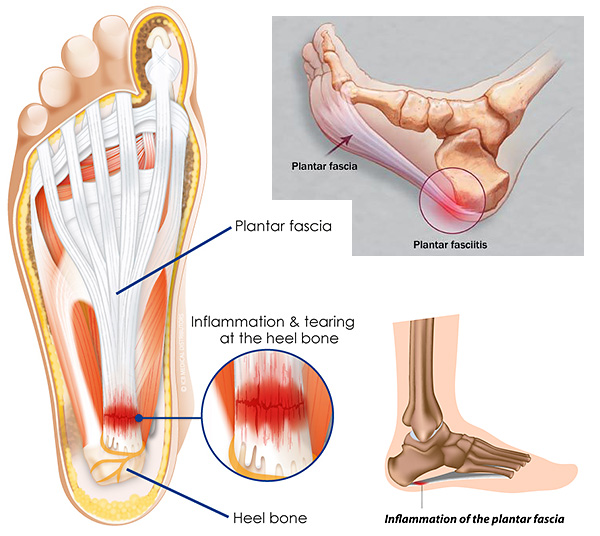Heel pain is one of the most common conditions seen in the foot. It can affect people of all age groups. Heel pain is generally the result of faulty biomechanics (walking gait abnormalities) that place too much stress on the heel bone and the soft tissues that attach to it. The stress may also result from injury, or a bruise incurred while walking, running, or jumping on hard surfaces; wearing poorly constructed footwear; or being overweight. Heel pain, sometimes disabling, can occur in the front, back, or bottom of the heel.

Plantar Fasciitis, inflammation of the plantar fascia is the most common cause of heel pain.
A condition associated with heel pain is heel spur, a boney growth on the underside of the heel bone. The spur, visible by X-ray, appears as a protrusion that can extend forward as much as half an inch. Heel spurs result from strain on the muscles and ligaments of the foot, by stretching the long band of tissue that connects the heel to the ball of the foot, and by repeated tearing away of the lining or membrane that covers the heel bone. These conditions may result from biomechanical imbalance, running or jogging in improperly fitted or excessively worn shoes, or obesity.
Both heel pain and heel spurs are frequently associated with an inflammation of the band of fibrous connective tissue (fascia) running along the bottom of the foot, from the heel to the ball of the foot. The inflammation is called plantar fasciitis.
The condition occurs when the plantar fascia is strained over time beyond its normal extension, causing the soft tissue fibers of the fascia to tear or stretch at points along its length. This leads to inflammation, pain, and possibly the growth of a bone spur where it attaches to the heel bone.
Shoes that lack appropriate support, especially in the arch area, may aggravate inflammation of the plantar fascia. In certain cases, chronic plantar fasciitis develops due to on-going irritation of this area. This may occur in individuals who is involved with athletic activities as well as people who spends a lot of time working on their feet.
Resting provides only temporary relief. Very often people will find pain is worst during those first few steps after a period of rest such as after a night’s sleep or sitting on a chair. As you walk, the heel pain may lessen. The pain often returns after prolonged rest or extensive walking.
Heel pain sometimes results from excessive pronation or excessive inward motion of the foot. It can create an abnormal amount of stretching and pulling on the ligaments and tendons attaching to the bottom of the heel bone. Excessive pronation may also contribute to injury to the hip, knee, and lower back.
Heel pain can also occur in children, most commonly between ages 8 and 13. Please see Children’s Heel Pain for more information about this condition.
Treatment
Early treatment and intervention is crucial to end heel pain as this condition can become chronic and difficult to eradicate. A doctor specialized in feet will guide you through a series of conservative treatment to help you back on your feet. Treatment options may include stretching, icing, massage, temporary support or immobilization, and custom orthotics.

Calf stretches – one of the recommended treatment for plantar fasciitis.
In certain cases, anti-inflammatory medications may be prescribed to provide temporary relief. The doctor may also order xrays to evaluate for any bone spurs or offer a steroid injection. The majority of patients who suffer from plantar fasciitis will improve with conservative treatment. In rare cases, aggressive form of physiotherapy or other therapeutic modalities may be recommended by the doctor; very seldom would surgery be required.
Contact us today for a consultation with our foot specialist who can help put you back on your feet!

